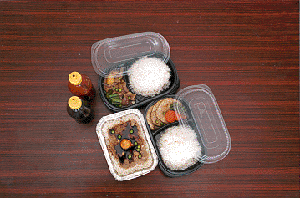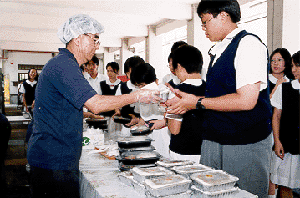| POINTS TO DO |
WHY? |
- Only purchase raw materials from reliable and reputable sources.
|
- Ensure hygienic quality of food.
|
- Pay attention to the conditions of food materials. Reject exposed food and food which looks, smells or tastes abnormal.
|
- Safe food starts with safe ingredients.
|
- Keep a record of receiving.
|
- A good record helps investigation when a food incident occurs.
|
- Read the label of prepackaged food, adopt First-in first-out for better food rotation.
|
- Ensure the food is not beyond its durability; food is of the type you want; and follow the storage condition and the instruction for use on food labels.
|
- Keep raw meat and perishable food below 4℃ inside the refrigerator. Keep cold foods cold (at 4℃ or below), hot foods hot (above 60℃).
|
- Bacteria in food grow and reproduce fast within the dangerous temperature zone from 4℃ to 60℃.
|
- Separate cooked food from raw food.
|
- Reduce risk of cross-contamination.
|
- Always place food on food shelf 0.5m above floor.
|
- Prevent contamination of food by floor or related activities.
|
- Food should be stored in impervious containers wrapped with cling wrap or covered.
|
- Prevent cross-contamination of food during storage.
|
- Enough space should be kept between trays of food.
|
- Allow cold air to reach every part of refrigerator.
|
- Store cooked food in shallow containers.
|
- Allow fast cooling of cooked food.
|
- Perishable food should not be stored too long in refrigerator.
|
- Refrigeration only slows down bacterial growth but does NOT kill bacteria.
|
- Wash all fresh food before cooking.
|
- To wash away dirt adhered on food surface.
|
- Thaw frozen meat and poultry thoroughly before cooking. Cut chunky meat into smaller pieces before cooking.
|
- Temperature used during cooking may not be sufficient to kill all micro organisms if all parts are not completely thawed.
|
- Thaw frozen food between 0°C and 4°C.
|
- Keeping at low temperature can lower the rate of multiplication of bacteria.
|
- Avoid preparing food too far in advance before consumption.
|
- Shorten the time for bacterial growth as far as possible.
|
- Cook food thoroughly. Make sure the centre of the food reaches a temperature of at least 75℃. Use thermometer to measure if in doubt.
|
- Thorough cooking kills bacteria.
|
- Reheat foods/leftovers thoroughly as above (i.e. not less then 75℃).
|
- Thorough reheating kills bacteria which develop during storage.
|
- When preparing cold mixed dishes, e.g. salad, always cool the cooked component before adding other ingredients.
|
- Large amount of hot food cools down slowly, and during that period, bacteria from other ingredients may multiply.
|
- Provide separate sets of utensils for handling of raw food and cooked food. Utensils just have been used for raw food should not be used to prepare cooked food unless they have been washed and sanitised thoroughly.
|
- To prevent cross-contamination as utensils for raw food are contaminated with bacteria.
|
- Always keep your premises clean, in particular the kitchen and the toilet.
|
- Dirty environment and accumulation of miscellaneous articles attract rats and vermin. Unclean environment is a potential reservoir of bacteria.
|
- Put rubbish and food wastes into impervious waste containers and keep lids of containers closed at all times.
|
- Leave no rubbish, food wastes and smell for rats, flies and vermin.
|
- Protect kitchen and storage area from insects and other vermin. Employ pest control professionals to eliminate pest if infestation exists.
|
- These pests may carry pathogens. Pest control professionals can eliminate vermin more effectively and minimise the possible outbreak of chemical food poisoning.
|
- Make sure refrigerators are kept in good working condition. Clean and defrost them regularly to avoid frost accumulation.
|
- Assure food is stored at a temperature of 4℃ or below and the refrigerator is clean.
|
- Wash used utensils with clean water and detergent and then sanitise them in either boiling water or an approved bactericidal agent.
|
- To reduce bacterial load on utensils.
|
- Keep all dangerous chemicals such as disinfectants and insecticides in labelled and closed containers and away from kitchen area.
|
- To prevent the possible chemical contamination of food.
|
- Wear clean and light colour outfit.
|
- Avoid contamination of food with microorganisms and any foreign objects.
|
|
|
- Prevent hair from falling into food.
|
- Remove jewellery before working.
|
- Besides making handwashing less effective, jewellery may fall into food accidentally.
|
- Bandage wounds and septic sores on hands and arms with waterproof dressings.
|
- Wounds and septic sores may be infected with bacteria.
|
- Wash hands thoroughly with soap and water every time before/after work and after visiting toilet.
|
- Hands carry bacteria. Plain water only cannot remove bacteria and dirt.
|
- Turn away from food and cover your nose and mouth when sneezing and coughing. Use a paper towel and wash hands immediately afterwards.
|
- Healthy people may carry bacteria in their nose and throats.
|
|
|
- Cigarette ash and butts can fall into food. It may also bring bacteria from smoker's mouth to food.
|
- Cooked food should not be touched by hands.
|
- Bacteria present on hands are transferred to food through direct contact.
|
- Report to the employer if suffering from sore throat or gastro-intestinal disturbances like diarrhoea and vomiting.
|
- Sick employees may have to be temporarily assigned for other tasks not involving food preparation, so that their risk of spreading of pathogens can be minimised.
|
- Employers should provide job-related and food hygiene training to all staff. Both employers and employees should attend food hygiene training seminars/ courses run by the government and accredited institutions.
|
- Enhance their food hygiene knowledge and make them aware of the importance of food hygiene and safety so that they will adopt good food hygiene practices.
|

